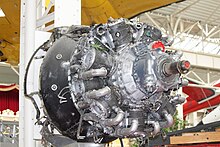Bristol Hercules
The Bristol Hercules was a double radial engine with 14 cylinders and valve control made by the Bristol Engine Company . Developed from 1936 onwards, the engine was built 57,400 times and used in many British aircraft during World War II .
history
In the 1930s, Bristol introduced its first valve control on the 750 PS (550 kW) Perseus and the 500 PS (370 kW) Aquila . The development of aircraft engines at that time was so rapid that both engines quickly reached their performance limits and were outdated. In order to remain at the forefront of aircraft engine manufacturers, Bristol developed a 14-cylinder version of each of the two engines. Perseus' successor was Hercules , while Aquila was replaced by Taurus . The Taurus was also a 14-cylinder double radial engine, but had a smaller displacement (25.36 liters) than the Hercules .
The first Hercules engines were available in 1939. Initially, as the Hercules I, they made 1290 hp (960 kW). The next stage of development, the Hercules II , already achieved 1375 hp (1025 kW). The power of the Hercules VI was already 1650 hp (1230 kW) and at the end of the war the Hercules XVII finally reached 1735 hp (1294 kW).
construction
The seven cylinders of the rear star plane of the air-cooled double radial engine were arranged offset so that they peeked out between the seven cylinders of the front star. This also gave them a sufficient flow of cooling air. The Hercules had - like the larger Bristol Centaurus with 2 × 9 cylinders - a valveless slide control according to Burt-McCollum. This made it possible to achieve higher compression ratios, the mechanical efficiency increased compared to an OHV valve control, the piston temperature was lower than with two-valve engines and higher speeds could be achieved, which benefited the engine's performance. The only disadvantage of this type of construction was the significantly higher construction and manufacturing effort.
In total, over 57,400 Hercules were produced.
use
The Bristol Hercules powered a number of aircraft - including the Bristol Beaufighter designed as a fighter . However, it was commonly used in bombers such as the Short Stirling , the Vickers Wellington , the Avro Lancaster Mk.II, and in all late versions of the Handley-Page Halifax . It was considered one of the most reliable aircraft engines of the time and was popular with pilots and mechanics.
After the war, the Hercules was also used in civil aircraft - including the Bristol Freighter , the Short Solent flying boat and the manufacturer Handley-Page in the Hastings and Hermes . It was also produced under license from SNECMA in France for the Nord Noratlas .
A Hercules 759 from a Nord Noratlas is used by Josef Gartner GmbH for testing glass facades. Among other things, the facade of the Elbphilharmonie was tested for leaks.
Technical data of the Hercules VI
- Type: 14-cylinder four-stroke double radial engine with air cooling
- Valve control: "Burt-McCollum" slide control with three inlet and two outlet channels
- Bore: 146 mm (5.75 in )
- Stroke: 165 mm (6.5 in)
- Displacement: 38.67 liters (2,360 cui. )
- Compression: 7.0: 1
- Output: 1650 hp (1213 kW) at 2800 rpm
- spec. Output: 42.7 hp / l (31.4 kW / l)
- Mass: 765 kg
- Power-to-weight ratio : 0.464 kg / PS (0.631 kg / kW)
See also
Individual evidence
- ↑ Hurricane with announcement. In: B4B Swabia. vmm Wirtschaftsverlag GmbH & Co. kg, accessed on October 29, 2009 : "Façade builder Gartner tests high-rise facades for weatherability: dynamic facade test with 2,000 hp aircraft engine."
- ↑ Bärbel Scheele, Michael Wech: Elbphilharmonie in the spotlight. (No longer available online.) In: Adventure Knowledge. ZDF.de, October 28, 2009, formerly in the original ; accessed on October 29, 2009 : "... a 2200 HP aircraft engine generates gusts of wind from 110 to 150 kilometers per hour."
Web links
- Bristol Hercules sleeve valve radial animation. You Tube, accessed on October 17, 2009 (English, animation of the slide control).



